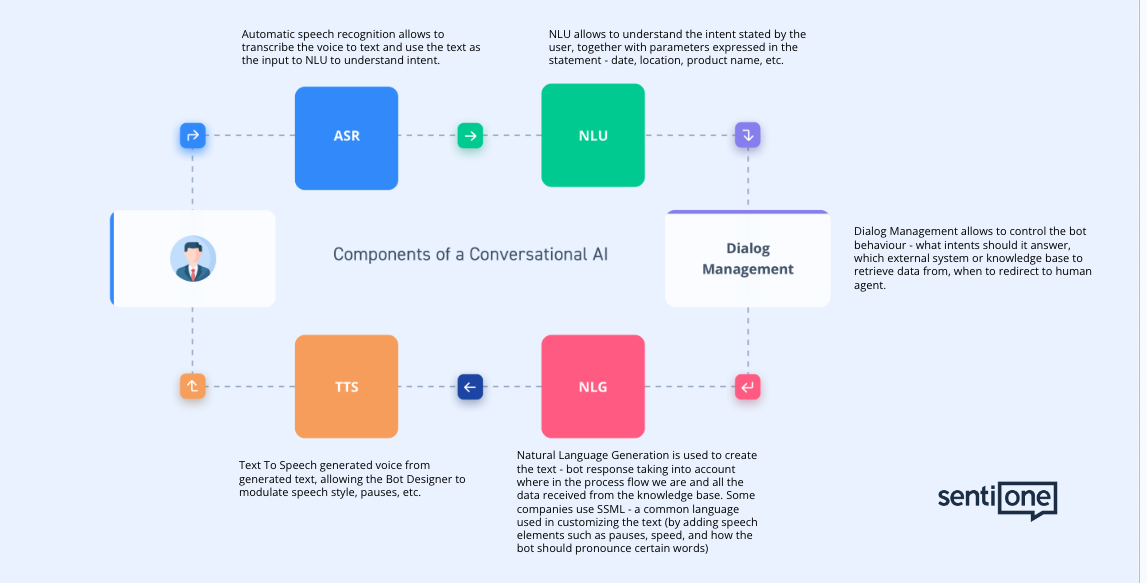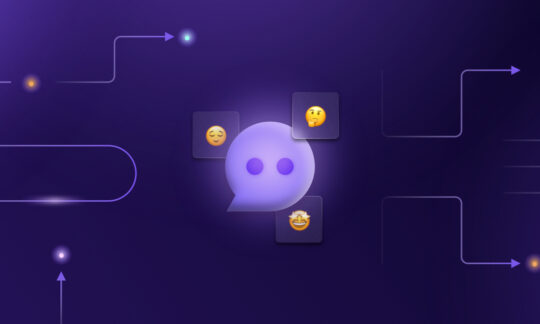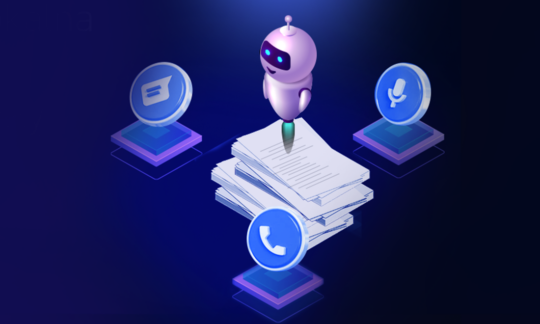What Is a Voice Bot? An Overview of the IVR Replacement in Call Centre Automation
Table of contents
- What Is an AI Voice Bot?
- Voice Bot AI: IVR Replacement for Call Centre Automation
- Evolution of Voice Chatbots – AI Assistant Powered by Generative AI
- Why Businesses Need Voice Bots
- The Challenges of Building Voice Bots
- The Future of AI Voice Bots
- How to Choose the Right Voice Bot Platform for Your Business?
- SentiOne Automate: Voice Bot Platform for Bot Designers
- Useful Definitions
- Article Summary
In our modern era, it’s hard not to find another article on how AI voice bots are making waves in the business world. When it comes to call centre automation at banks, financial institutions, tourism agencies – it’s no different.
With the trend growing toward self-service, voice bots are making a huge difference for businesses that invest in customer service automation. Bot designers are also given opportunities to make an impact for these organisations with their ability to implement these voice bots.
In one of the first articles of our Bot Building Series, we’ve defined what a chatbot is. The aim of this article is to provide bot designers with an introduction to voice bots given their ever-rising demand among businesses as well as the benefits of implementing voice bots as an IVR and call steering replacement.
We’ll begin with the basics. In this article, you will learn about:
- Voice bot design and building
- Types of voice bots and their use cases
- The application of generative AI in voice bot construction
- Impact voice bot AI has on contact centres
- The future of Artificial Intelligence voice bots
What Is an AI Voice Bot?
Voice bots are basically voice-enabled chatbots, an AI-based software that takes voice commands and replies by voice. They are extensively used in various applications such as call centres, mobile apps, and messaging platforms (e.g., WhatsApp).
Like chatbots, voice bots have progressed incredibly fast: they are able to be much more context-aware, provide personalised responses, accurate answers at mass, and overall more fluid and human-like interactions.
With these advancements, voice bots have been able to replace IVR and call steering systems for hundreds of businesses – and that’s probably for the best.
Voice Bot AI: IVR Replacement for Call Centre Automation
For nearly a decade, Interactive Voice Response (IVR) systems have been the backbone of customer service in many sectors, including banking, finance, tourism, and more. IVR is a call centre automation that has customers follow a series of pre-recorded messages so that in the end they can be redirected to the live agent.
While IVR systems have effectively managed call routing for years, their limits are becoming more obvious in the face of technological developments in conversational AI. Whenever someone calls a business and has to deal with an IVR, there are many reasons for customers to be dissatisfied with the experience:
- IVRs demand patience from the person calling as they have to wait to hear their options listed
- Mistakes are easily made if the person presses the wrong button (and can’t go back)
- IVRs don’t allow for context – which means if your options aren’t presented, you need to go to the general enquiries line
That’s why AI voice bots are changing the game. Instead of having customers wait for their options, press buttons, and risk having a frustrating experience, AI voice bots talk to you like a live agent would.
Voice bots bring a new level of sophistication to the customer service realm which allows businesses to handle more complex inquiries, provide personalised customer interactions, and deliver a better overall customer experience, while saving operating costs.
Moreover, voice bot AI can learn and improve over time, thanks to the capabilities of machine learning. As they handle more interactions, these conversational bots become smarter and more efficient, further enhancing their service quality. Therefore, the switch from IVR systems to AI bots represents a significant leap in customer service technology, offering better efficiency, flexibility, and satisfaction for customers.
How Do Voice Bots Work?
While voice bots and conversational AI chatbots share many operational similarities, voice bots incorporate two crucial steps: Automatic Speech Recognition (ASR) and Text-to-Speech (TTS). ASR, at the beginning of the interaction, translates the user’s spoken command or question into text. TTS, at the end of the interaction, transforms the generated text response back into spoken language. Here’s what the full voice bot process looks like:
- The User Command or Question: The interaction starts with the user posing a question or issuing a command to the voice bot. This verbal communication could range from a simple query to a complex request.
- Automatic Speech Recognition (ASR): This technology translates the spoken message into text. The voice bot then uses this textual input for Natural Language Understanding (NLU). The accuracy of ASR is crucial as it sets the foundation for all subsequent steps.
- Natural Language Understanding (NLU): NLU deciphers the intent of the query and any expressed parameters, such as date, location, or product specifics. This technology enables the voice bot to understand the context and semantic meaning behind the user’s input.
- Dialogue Management: This component determines where to retrieve the relevant data from to respond to the user’s query. It could be from an external system, a knowledge base, or perhaps it may identify that the query is complex enough to warrant redirection to a human agent.
- Natural Language Generation (NLG): Based on the retrieved data and understanding of the user’s intent, NLG creates a coherent text response. It considers all available data points and knowledge to construct a comprehensive and precise reply.
- Text-to-Speech: Lastly, the generated text is converted back into spoken language. TTS also adds prosody, intonation, and other speech characteristics to enhance the naturalness of the spoken output. It modulates the speech style to emulate human-like conversation, enhancing the overall interaction experience for the user.

The voice bot process and components
Evolution of Voice Chatbots – AI Assistant Powered by Generative AI
While generative AI technologies like ChatGPT have their unique strengths, they currently don’t meet the requirements for effective automation of customer service tasks within a business setting, and hence, fall short of the capabilities of dedicated conversational AI bots.
Still, the ChatGPT application in building Natural Language Understanding (NLU) can accelerate the voice bot creation process significantly by as much as 60%. ChatGPT’s utilisation is manifold when designing conversational experiences:
Generating Training Phrases: It can automatically produce a wide range of training phrases, ensuring that the voice-based chatbots can recognise and respond accurately to various user inputs. This reduces the time needed for manual input generation.
Synthesising Industry Terms: ChatGPT can effectively generate a list of synonyms for industry-specific terminology. This not only broadens the voice bot’s vocabulary but also enables it to understand and respond to diverse user inputs, even when they are phrased differently.
Creating Dialogue Flows: With ChatGPT, bot designers can automatically create complex dialogue flows. These flows ensure smooth and logical progression of conversations, providing users with an engaging and efficient conversational experience.
These capabilities quicken the process of training the AI bot, allowing bot designers to produce more efficient, engaging, and brand-aligned messaging.
Why Businesses Need Voice Bots
There are several major advantages to incorporating voice bots into your business communications strategy. From speeding up customer support tickets to accomplishing specific tasks, we’ll explore each one by one.
IVR Replacement – Leveraging Natural Language Understanding (NLU), voice bots interpret a caller’s intent, streamlining interactions. Unlike traditional systems, where users navigate through various options like “Press 1 for reservations,” with conversational voice bots, a customer can directly express their needs, such as “I want to book a meeting with an advisor.” The voice bot, understanding the intent, books the meeting or, if needed, promptly directs the caller to the appropriate team or agent. This advancement not only significantly saves time for human agents in customer service teams but also enhances the user experience.
Streamlines FAQs – Information-oriented voice bots streamline customer interactions by readily answering common queries or FAQs such as “Where’s the nearest branch?”, “When can I meet with an advisor?”, or “What are your opening hours?”. They function as an effective tool in providing quick, accurate information and enhancing customer service efficiency.
Accomplishes Tasks Faster – Task-oriented or transactional voice bots automate specific processes, acting on behalf of customer service agents. These advanced voice bots can perform actions such as ordering a new credit card, scheduling a meeting with a sales advisor, or reporting a complaint, thus streamlining the customer service process and enhancing efficiency.
Shorter Waiting Times – Customers don’t have to wait on hold or wait to get assistance. Many customers are often frustrated by waiting or being misunderstood by the call steering system.
Understanding Customer Intent – As mentioned above, voice bots rely on NLU to process the intention of the user and respond intelligently, thereby improving a customer’s experience with a brand. Improved customer experience leads to brand loyalty.
Personalised Interaction – Voice bots can deliver hyper-personalised responses based on a customer’s past interactions and data, such as name, client ID, or date of birth.
The Challenges of Building Voice Bots
So far, we’ve talked about how voice bots work and how they can benefit businesses that utilise contact centres. However, building an AI bot presents several challenges, starting with the initial setup which includes designing the bots, defining processes, intentions, and key phrases. Your voice bot is only as good as your dataset and the training you give it. Here are some challenges you may face and ways in which bot designers overcome them:
Designing dialogs and processes – Creating an exhaustive list of possible dialogs and processes to be automated can be a complicated process. First, you’ll need to provide an exhaustive list of customer journey prompts and specify them for chatbots. This process can be quite lengthy, but relying on ChatGPT to generate a step-by-step flow can speed up the process. Those generated answers can then be transferred to your flow builder.
People not trusting bots – People are generally distrustful of bots, so making your bot sound more human can be a challenge. Bot designers can overcome this hurdle by feeding it phrases that represent your brand. When it comes to simulating human speech with an AI voice, a lot of companies will use SSML, a common language used in adding speech elements like pause, speed, and pronunciation.
Speech recognition tech is still developing – AI voice bots work in all major languages, but when it comes to voice recognition, the technology isn’t quite there to understand accents, dialects, and as well as some slang or informal speech. Only time will tell when speech recognition technology will advance enough to capture all these details in real-time.
The Future of AI Voice Bots
The advent of voice bots in the last decade has caused a stir for consumers as well as businesses and how they communicate. Here are some of the most current trends in the world of AI bots:
Integration with ChatGPT technology – Giving your voice bot enough information that it has a big enough repertoire of phrases and terminology to understand user input is critical in the bot-creation process. ChatGPT can speed up the process by generating terminology quickly and effectively in the initial voice bot setup.
Speech Recognition – Some companies are using SSML to customise how natural speech sounds. It can emulate human speech by incorporating pauses, accents, pronunciation, speed, and intonation. For example, Google’s virtual assistant peppers its speech with “um”, “uh”, and “mmm hmm” to imitate the tics and rhythms of humans.
Contact Centres Shift to Voice Bots – Many organisations such as banks, airports, hotels, and more are shifting away from legacy contact centres to chatbots and voice bots in mobile apps, communication channels and websites. As we mentioned in the beginning of the article, an increasing number of customers prefer to talk to bots rather than human agents.
How to Choose the Right Voice Bot Platform for Your Business?
When choosing a voice bot platform, it’s important to consider one that will allow you to build a voice bot effectively, analyse its performance, and automate testing to improve AI effectiveness over time. Here are the many ways SentiOne Automate can help bot designers get the most out of their AI voice bots:
Easy-to-build Interface: Being able to create a voice bot that’s easy to build and implement is a must for those who don’t have a dedicated team of software engineers or highly technical bot designers. With SentiOne Automate, you can create intricate dialogues and chat flows with ease using our drag-and-drop, low-code/no-code interface.
Real-Time Bot Analytics – Gain a deeper understanding of your customer’s pain points by analysing your voice bot performance in real-time. Assess the bot’s ability to accurately answer customer queries and introduce new use cases over time to boost customer experience.
Automated Bot Testing – SentiOne Automate comes with a built-in bot testing feature so you can test your bots at scale (no need to manually test each one). Automatically test all conversation scenarios using the built-in chat tester or real-life interactions to ensure your bot’s readiness for all use cases. You can even categorise tests to keep track of all your findings.
Ongoing Training and Education – When choosing a voice bot platform, it’s important that you’ll have support to create and implement your bot. SentiOne Automate has well-documented training to help you understand the nuances of creating a chatbot.
SentiOne Automate: Voice Bot Platform for Bot Designers
As the demand for voice bot designers increases, so too will the need for an effective platform to design and implement voice bots from start to finish. SentiOne Automate helps bot designers make the process as seamless as possible. If you’re interested in learning more about voice bot best practices and how to implement them today, download our whitepaper today. If you have any questions, schedule a call with our team of experts.
Useful Definitions
- IVR – Interactive Voice Response (IVR) is a system that uses voice and keypad inputs to navigate callers through a phone system before reaching a human operator.
- Call Steering – Call steering uses AI and voice recognition to understand spoken requests and automatically direct callers to the correct department or resource.
- Chatbot vs. Voice bot – A voice bot is a chatbot with a voice. A chatbot is a type of software that communicates through a “conversational interface.” They are most often employed by businesses as virtual customer support agents to relieve staff from answering repetitive queries.
- Bot Design (Conversational Design) – The process of designing a chatbot (bot creation) that talks like a person with whom a user can hold a conversation in a way that mimics human-to-human interactions. AI bots are designed in a way that feels personalised and yet can give highly accurate responses given their ability to integrate with external APIs including CRMs, internal tools, and databases. Bot design also takes into consideration the brand you’re designing for and ensures tone and messaging are in line across all communications.
- Bot Building (Bot Development) – The process of how bot designers more concretely build a chatbot from the ground up, including each and every component (natural language understanding, processing, input & output) of the conversation, how they’re linked to each other, and how designers connect the bots to external information including APIs, CRMs, and databases to gather information.
- NLU vs. NLP – NLU, or natural language understanding, is focused on the human elements of communication, including the intention of the communication. NLP, or natural language processing, on the other hand, is focused on breaking down large sets of data and processing text in its literal form.
- LLM – A large language model (LLM) is a type of AI algorithm that uses deep learning techniques and massively large data sets to understand, summarise, generate, and predict new content.
- SSML – Speech Synthesis Markup Language is a type of code that helps computers read text out loud in a way that sounds more like natural human speech.
Article Summary
This article provides an overview of voice bots and their role in call centre automation as a replacement for Interactive Voice Response (IVR) systems. Voice bots are voice-enabled chatbots that use AI to understand and respond to voice commands. They are used in call centres, mobile apps, and messaging platforms. AI voice bots offer benefits such as personalised responses, accurate answers, and improved customer experience. The article also discusses the challenges of building voice bots, the future trends in AI voice bots, and how to choose the right voice bot platform for your businesses.



